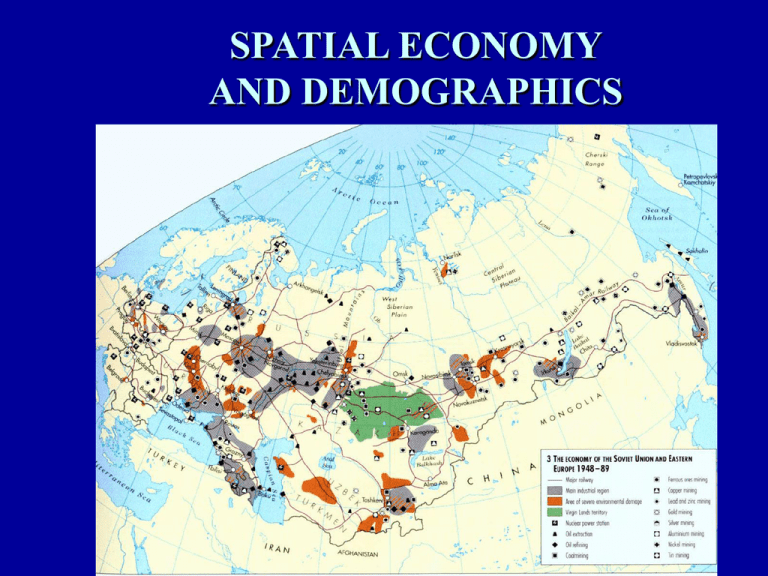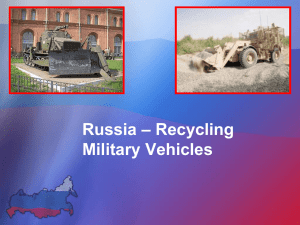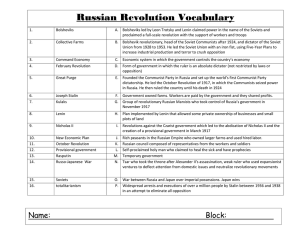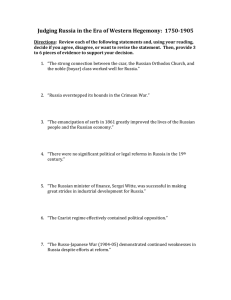SPATIAL ECONOMY AND DEMOGRAPHICS
advertisement

SPATIAL ECONOMY AND DEMOGRAPHICS USSR Population (Lost 15 mil to civil war/Stalin and 14 mil to WWII; Male shortage one reason for women in both workforce & home) 300 Millions 250 Despite Annexations! 200 150 Population would have been 440 million in 1991 without wars 100 50 0 1939 1950 1991 “State Socialism” • Central planning of “Command Economy” • Guaranteed job, low rents, health care, daycare, etc. • Heavy industrialization to catch up to West • Forced collectivization of private farmlands Industrial regions Mutually dependent/ not self-sufficient • Ukraine (Donbass) • UralsUkraine Urals (Donbass) • Siberia (Kuzbass) Siberia (Kuzbass) Donbass & Kuzbass Donbass coal fields, E. Ukraine/ Russia bank of Don. Coal/steel region since 1870s Kuzbass coal fields, W. Siberia Russian urban population • Soviets favored large industry over farms & cities – Moscow 30% industrial; Paris only 5% • Urbanization but without urban services/transit/life • Prefab worker apartment blocs / housing shortages Soviet bloc city Budapest, Hungary Russian urban population Overwhelmingly in largest cities 80 Percentage of population in cities 70 60 50 40 30 20 10 0 1917 1939 1959 1989 Russian migration • Soviet controls over movement, travel • Encouraged moves to big cities, labor shortage areas, frontier zones • Skilled Russians move to other republics, frontier • 3 mil. Russians moved back to Russia, 1990s Soviet rural economy • At first divided aristocrats’/ church estates for peasants • Stalin forced collectivization of private farms • Consolidated farmland into Kolkhoz (Cooperative Farm) and Sovkhoz (State Farm), like large estates • Same in E. Europe 1950s (except Poland, Yugo.) Drawbacks of Soviet agriculture • Stalin murdered Kulaks (well-off peasants), 1930s • Peasants had low status, little incentive • Command agriculture irrational, favored larger towns; Ended up importing food by 1980s Gorbachev’s rural changes • Broke state land monopoly, allowed private leases and withdrawals from state farms • Sell the land? Losing Mir (rural commune) tradition • Fears of food insecurity, new rural elite, lack of training Results of rural changes • Millions of private farms (esp. in south) • But state farms/coops keep 75% of land, with more democracy, shareholding, efficiency • Interdependence of old state farms, new private • Some old estates revived in E. Europe; and some corporate agribusiness “Shock therapy” • Close command industries • Reduce or end subsidies • Pass burden to renters • Privatize industrial economy; benefit new entrepeneurs • High unemployment, inflation, inequality Winning regions • Hub regions - Government/transportation centers. High-tech industries - Moscow, St. Petersburg, Kiev, Nizhny Novgorod, Urals • Gateway regions - Outward looking/ trade-oriented - Vladivostok, Murmansk, Kaliningrad Losing regions Huge gaps in prices, income, roads • Command military-industrial / coal regions • State agricultural regions • Remote natural resource (non-oil) • Ethnic minority regions in conflict Favorable regions of Russia Unfavorable regions of Russia Russian agricultural employment Communist vote in 1995 Duma election Agricultural zone; older population. Nationalist zones bordering Muslims, East Asians Russian industrial employment Reform party vote in 1995 Duma election Educated urban areas; Mixed industry-agriculture; North, east less serfdom history Russia’s demographics, 1990-2006 Male Female Effects of war, poor male health Russian birth rate 18 Birth rate per 1000 16 14 12 10 8 6 4 2 0 1985 1991 1996 Russian death rate Death rate per 1000 16 14 12 10 8 6 4 2 0 1985 1994 1996 U.S. Baby Boom USSR instead had “echo busts” slowing growth in 1960s, 1980s Baby Boom (1946-1964) Echo Boom Baby Bust (1965-1980) Russian life expectancy Men dying from alcohol, drugs, accidents, crime; Male life expectancy now like parts of Third World 80 Male Female 70 60 50 40 30 20 10 0 1986 1995 Russia’s population decline Population decline for first time since WWII; Worries about aging population, labor shortages; Larger families in Muslim regions but not as many industrial workers







